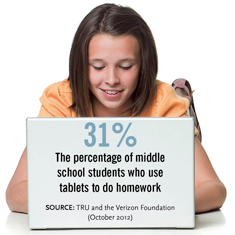Innovative Strategies for Ensuring Device Equity
When I began teaching as a librarian in Harlem in the 1990s, my district was embarking on what was then considered an innovative program: putting a pod of four computers in every classroom. I still recall cringing as I heard some teachers say to students, "If you finish your work early, you can go 'play' on the computer." Back then, failing to recognize these devices' powerful learning potential was all too common.
I loved having the opportunity through my job to expose children to a world of possibilities through books. Access to computers and the Internet took that to a whole new level, giving students instant feedback and interactivity while empowering them to become producers — rather than simply consumers — of information. I watched many of them discover creativity they didn't realize they had. Suddenly, they were using technology to draw, illustrate, write, connect and create professional-looking work that they couldn't wait to share with their families and the school community.
Many of my colleagues were amazed by the way students transformed when they came to my library. But all I was doing was providing the resources and guidance. Armed with that, our students took hold of their learning and went in directions we could not have imagined.
You may be wondering how the librarian at a cash-strapped, inner-city school could provide students with such learning opportunities. Although we had four computers in each classroom and a lab for "drill-and-kill" standardized-test preparation, our school was technology poor.
But I believed in the importance of access for every student, so I came up with innovative ways to ensure that technology was available to them when they were in the library. This meant not only allowing students to bring their own device (if they had one), but also helping students — and the school — acquire devices at little or no cost.
Here are four ways to ensure device equity even when budgets are tight or nonexistent.
Tap into the power of networking. Ask friends, colleagues and even acquaintances if they know or work for companies that are refreshing their computers. Within a week of doing that, I found a public relations firm that was planning to update its entire inventory of computers. The firm agreed to donate the devices to my school. I just needed to figure out a way to get them there.
I discovered through my networking that another friend was moving and convinced him to transport the computers from the PR firm to my school in his rental truck. Asking around also led me to someone who had the technological expertise to help me and three school volunteers configure the computers.
Consider leasing and discount purchasing programs. Many manufacturers offer leasing programs that allow parents and schools to acquire computers and other hardware at lower prices that can be paid over time. Terms vary, so it's important to read the fine print before committing.
Also, be on the lookout for affordable ways to acquire devices at deep discounts. As a Google Certified Teacher, I was particularly excited when I discovered that Google had established a program through which consumers could lease a Chromebook for $20 to $30 per month and then own the device outright after three years.
Another great resource is DonorsChoose.org, an online charity through which donors can help teachers acquire the tools they need for specific classroom projects. In December 2012, for example, the site ran a Chromebooks for Classrooms promotion through which public school teachers could request up to 30 Samsung Series 5 Chromebooks at a discounted price of $99 apiece.
Connect with companies that provide low-cost technology to students in need. The Computer Recycling Center in Northern California, for example, runs a Computers & Education reuse program that provides refurbished computers to schools and other California organizations in need. Educators in the state can apply for computers at crc.org/apply.
Nationally, there's CFY (formerly Computers for Youth), a nonprofit that helps students in low-income communities, along with their teachers and families, leverage technology to improve educational outcomes through its Digital Learning Program. Among other things, the program provides training for teachers, students and their parents, along with a free broadband-ready home computer loaded with educational software and 24/7 bilingual help desk support.
Even the federal government is providing support. Connect2Compete, a 2011 initiative of the Federal Communications Commission that became an independent nonprofit in summer 2012, offers millions of families who are eligible for the National School Lunch Program discounted $9.95-per-month broadband Internet, $150 refurbished notebook or desktop computers and free digital literacy training.
Connect with community resources. While there are many ways to ensure that students have access to technology during the school day, guaranteeing access when they aren't on campus can be problematic.
Reach out to resources in your community for help making access possible beyond school hours. The local library is an obvious place to start, but don't forget about the libraries on nearby college and university campuses. Community centers and local businesses also might be willing to make their computers available to students after hours and on weekends.
Remember: It never hurts to ask. You may be surprised by local organizations' willingness to not only provide facilities access, but also to donate used devices when they're no longer needed.
Access to Knowledge = Power
Ensuring that all students have access to the knowledge and skills they need to be successful in the world isn't just an economic issue; it's a civil rights challenge.
It's our responsibility as educators to provide all students with opportunities to connect, communicate, collaborate and create. Technology brings the world to them and allows them to pursue their passions in ways that teach them that what they do matters. Even when money is tight, there are ways to make access possible. All it takes is ingenuity.










